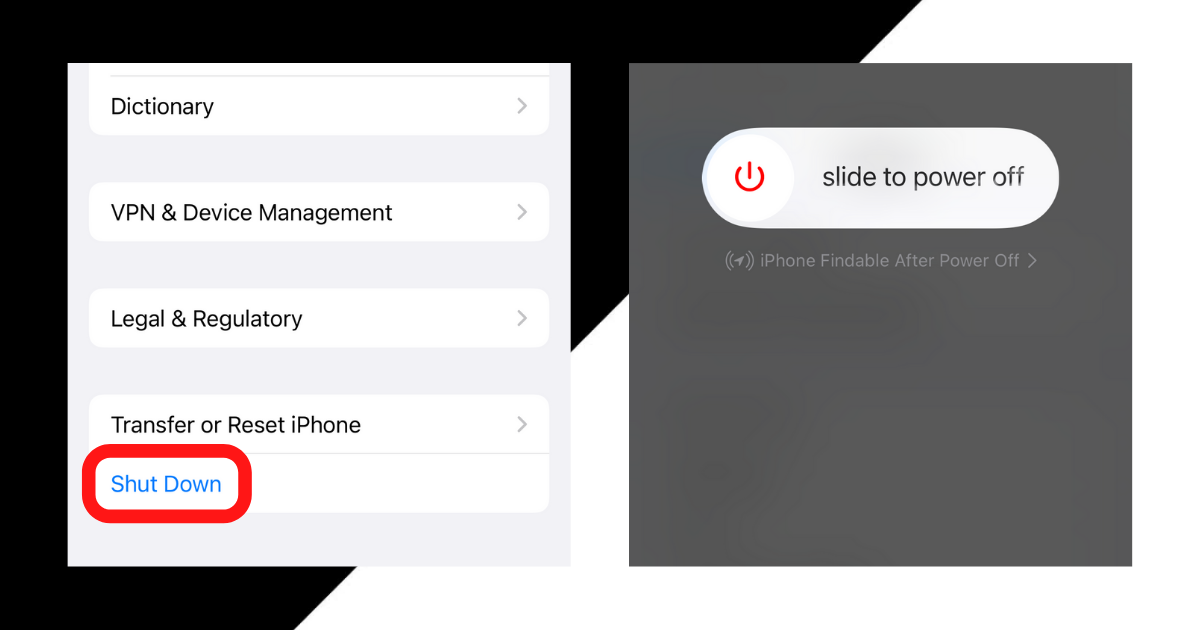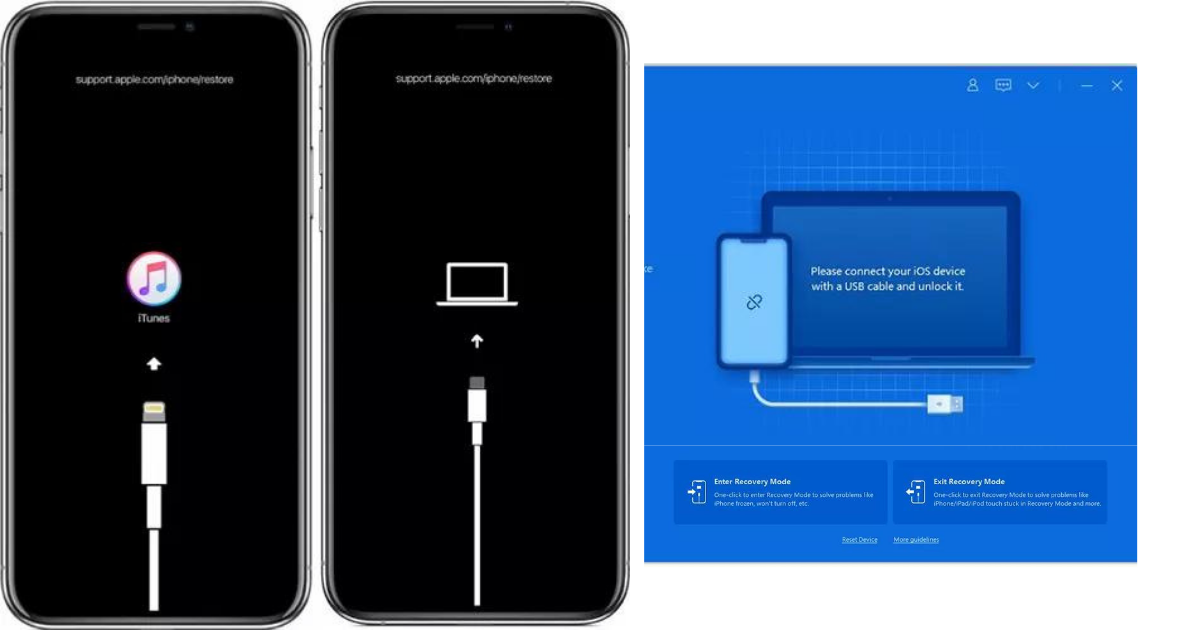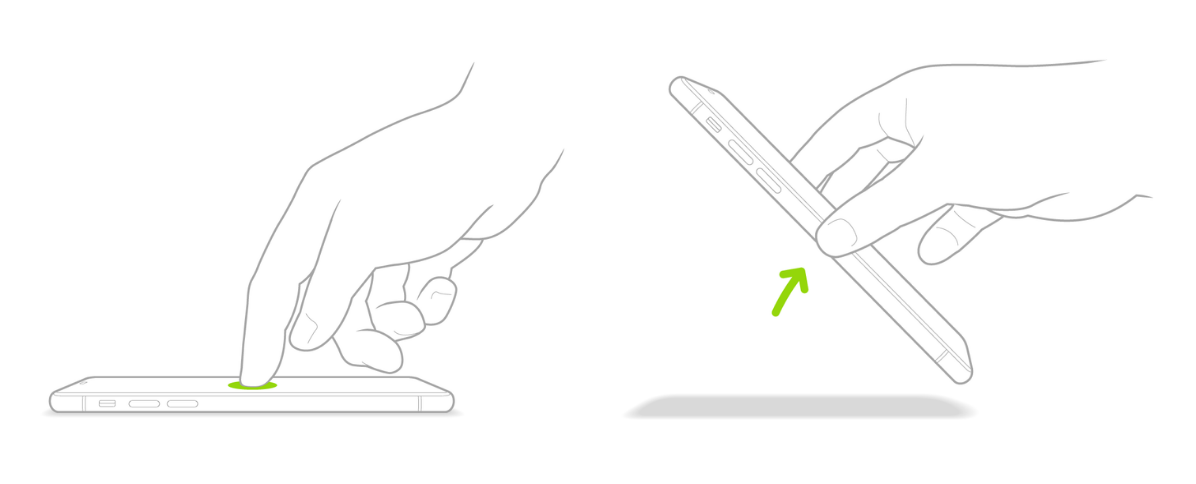If you’re here, you might be in a predicament where the Power button on your iPhone isn’t responding, and so, you’re unable to turn the iPhone off/on.
In this situation, there are a few things you can try that might get your iPhone up and running (or turn it off if it’s already on). In this article, we’ll go over a few general troubleshooting techniques that might help you turn on or shut down your iPhone without using the Power button.
How to turn off iPhone without Power button

It’s quite easy to turn off your iPhone without using the power button.
- Open the Settings app.
- Go to General.
- Scroll down and tap Shut Down.
- Swipe the slide to power off slider until the device turns off.
Now, if your iPhone is already turned off, and the power button isn’t responding, below are a few troubleshooting steps that might help you to turn it on without the Power button.
How to turn on iPhone without the Power button
Try Force-Restarting your iPhone
Just because the power button isn’t responding independently, doesn’t imply that it’s completely non-functional. If your device is frozen due to a software issue, you may still be able to force restart your iPhone by pressing the power button along with the Volume keys or the Home button.
The below section will guide you to perform a force restart on your iPhone.
To force restart iPhone with Face ID (iPhone X & Up): Press and quickly release the volume up button, press and quickly release the volume down button, then press and hold the power button for about 10 – 15 seconds. If everything is fine, your iPhone should reboot and you should see the Apple logo on the screen.
To force restart iPhone 8 or SE (2nd Generation): Press and quickly release the volume up button, press and quickly release the volume down button, then press and hold the power button for 10 -15 seconds. If everything is fine, your iPhone should reboot and you should see the Apple logo on the screen.
To force restart iPhone 7: Press and hold both the volume down button and the Sleep/Wake button at the same time for 10 -15 seconds. If everything is fine, your iPhone should reboot and you should see the Apple logo on the screen.
To force restart iPhone 6s or SE (1st Generation): Press and hold both the Power button and the Home button at the same time. If everything is fine, your iPhone should reboot in 10 – 15 seconds.
Charge your iPhone over USB
If pressing the power button fails to turn on your iPhone, another common fix you can try is to plug in the device for charging. It might have been that the device is not powering on due to a deep discharging of the battery.
Connect an MFi certified wall charger to a lightning cable, plug in your iPhone and let it charge for an extended duration. If your battery was discharged, uninterrupted charging for 2-3 hours might revive the battery and the device may turn on. Sometimes, the iPhone might even turn on within a few minutes of charging.
If the iPhone doesn’t turn on automatically even after charging it over an extended period, try to force restart the device by following the steps in the previous section. If that too doesn’t work, follow the below steps to attempt putting your iPhone in Recovery Mode and try to update or restore the device.
Put your iPhone into (and out of) Recovery Mode
Recovery Mode is often used to restore or reset an iPhone to its factory settings, using a computer. While in Recovery Mode, you may be able to set up the device as new with the latest iOS firmware, which might fix the issue with the power button, provided it was a software problem that caused the issue in the first place.
Before entering Recovery Mode, connect your iPhone to a Mac or PC. If you’re running macOS Catalina or a later version of macOS, open Finder. On an earlier version of macOS or a Windows PC, ensure you have the latest version of iTunes installed.
To put your iPhone in Recovery Mode and set it up again, do the following while the iPhone is connected to your computer:
On iPhone 8 or later, including iPhone SE (2nd generation): Press and quickly release the volume up button. Press and quickly release the volume down button. Then, press and hold the power button for 10 – 15 seconds.
On iPhone 7, iPhone 7 Plus, and iPod touch (7th generation): Press and hold the power and volume down buttons at the same time. Keep holding them for 10 – 15 seconds.
On iPhone 6s or earlier, including iPhone SE (1st generation), and iPod touch (6th generation) or earlier: Press and hold both the Home and power buttons at the same time. Keep holding them for 10 – 15 seconds.
If your device successfully enters Recovery mode, you should see a computer icon with a Lightning connector on-screen. On older devices, it may be the iTunes logo with a Lightning connector.
With the iPhone in Recovery mode, locate it on your computer, and try to Update your iPhone. This will update your device firmware to the latest iOS release without deleting data. If that doesn’t work, try to Restore it from a previous backup instead.
If the Update or Restore is successful, your iPhone should reboot automatically into iOS. If you weren’t able to restore or update, and the device is stuck in Recovery Mode, do the following to force the iPhone out of Recovery Mode without restoring it.
- Unplug your iPhone from the computer.
- Hold down the Power button until the iPhone turns off, and then let it go. Depending on your model, you may also need to hold the Volume Down button for 10 – 15 seconds.
If all goes well, the Apple logo should appear on the screen, and the device will boot automatically.
If your iPhone is still not powering on, this may indicate a problem with the power button or an internal hardware component failure. In such cases, the best option would be to get a Genius Bar appointment or visit an Apple-authorized service center.
But, in certain situations, your iPhone may not turn on due to a malfunctioning power button, and you may be able to switch on and use the device via software triggers.
How to Enter or Exit Recovery Mode if Power button is not working
If Power (or any other hardware button) is not working on your iPhone, you might need to put your device into and out of recovery mode using a software program like ReiBoot.

ReiBoot is an iOS system recovery software that helps you restore your iPhone to normal working condition from several issues, such as device stuck in a boot loop, Recovery Mode, etc.
One of the features of the software is that it allows you to enter and exit recovery mode in one click without pressing any physical button.
To enter or exit Recovery Mode on your iPhone using ReiBoot:
- Download and install ReiBoot on your Mac or PC.
- Connect your iPhone to your computer via USB, and launch ReiBoot.
- Ensure the device is recognized by the software. You may need to “Trust this computer” on the iPhone to establish the connection.
- When the connection is ready, click the Enter Recovery Mode or Exit Recovery Mode button on the ReiBoot UI to force the connected iPhone in or out of Recovery Mode.
Note: ReiBoot lets you use “Enter Recovery Mode” as many times as you want for free. But you may only use “Exit Recovery Mode” up to 5 times in the free version. You can remove that limitation by upgrading to the paid version of ReiBoot.
You can learn more about ReiBoot from our other article on how to repair iOS stuck on Apple logo, Recovery Mode, and other issues.
At this point, congratulations if you were able to successfully boot up your iPhone without the Power button. Regardless of whether your iPhone was able to turn on, you might still want to get the power button checked from Apple.
How to use iPhone without Power button
If you’ve managed to turn on your iPhone without the power button, the next obvious question is how to use it. On an iPhone that is already booted into iOS, the Power button serves 3 key functions:
- Turn off iPhone
- Wake iPhone from sleep
- Lock iPhone and turn off the display
Below, we’ll substitute these actions with software-based triggers.
We have already covered how to turn off the iPhone without the Power button earlier in this article. Now, let’s explore how to wake up or lock the device.

Turn on Tap to Wake:
- Go to the Settings app on your iPhone.
- Navigate to Accessibility >> Touch.
- Scroll down and turn on Tap to Wake.
Enable Raise to Wake:
- Go to the Settings app on your iPhone.
- Select Display & Brightness.
- Scroll down and enable Raise to Wake.
Turn on and configure AssistiveTouch:
- Go to the Settings app on your iPhone.
- Navigate to Accessibility >> Touch.
- Tap AssistiveTouch and turn the feature on.
- Next, tap Customize Top Level Menu and set up up to 8 shortcut icons.
- Tap on any one of the icons, select Lock Screen and tap Done.
Henceforth, whenever you pick up or tap on the screen, the display should light up and let you authenticate yourself with Face ID, Touch ID, or Passcode. When you want to lock the device, tap on the AssistiveTouch button on the screen and tap the Lock Screen shortcut.
Thus, you can turn off, turn on, and use your iPhone even without the Power button.